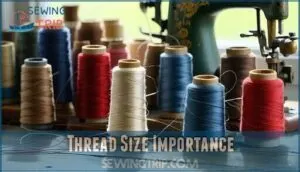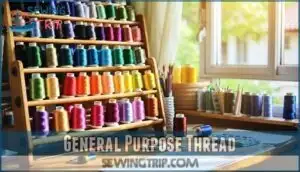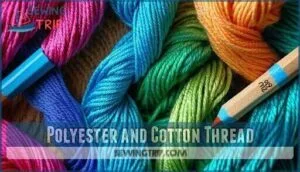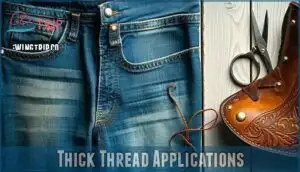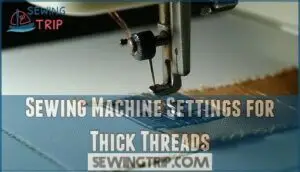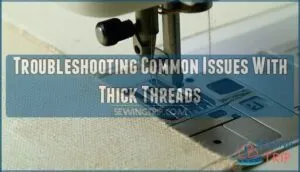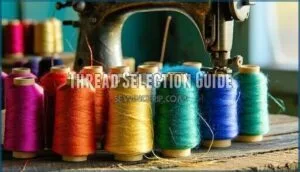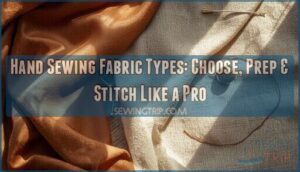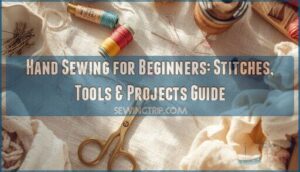This site is supported by our readers. We may earn a commission, at no cost to you, if you purchase through links.
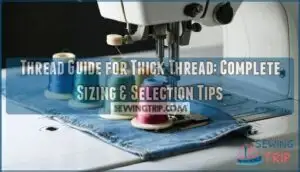 When you’re working with thick thread, the right thread guide for thick thread starts with understanding weight numbers—lower numbers mean thicker thread.
When you’re working with thick thread, the right thread guide for thick thread starts with understanding weight numbers—lower numbers mean thicker thread.
Size 12 to 30 threads work best for heavy fabrics like denim, canvas, and leather. Match your thread weight to your fabric’s density, and you’ll avoid that frustrating tug-of-war between thread and machine.
Check your needle size too—thick threads need larger needles to prevent breakage. Polyester threads offer durability, while cotton provides a classic finish.
Your machine’s tension settings become essential partners in this process. The secret lies in balancing all these elements for stitches that won’t just look good, but last.
Table Of Contents
Key Takeaways
- Match thread weight to fabric density – You’ll need size 12-30 weight threads for heavy fabrics like denim and canvas, while lighter fabrics require 50-60 weight threads to prevent puckering and ensure proper stitch formation.
- Adjust your machine settings for thick threads – You’ll need to lower thread tension, use larger needles (size 16-21), increase stitch length, and test on scrap fabric first to prevent thread breakage and skipped stitches.
- Choose the right thread material for your project – You’ll get better durability with polyester threads for heavy-duty work, while cotton provides a classic finish for natural fabrics and decorative stitching.
- Use proper needle compatibility – You’ll need needles with eyes 40% larger than your thread thickness to prevent jamming and ensure smooth feeding through your sewing machine.
Choosing Thread Size
You’ll need to understand thread sizing systems to pick the right thickness for your thick thread projects.
Thread size affects everything from stitch quality to machine compatibility, so knowing how weight, denier, and tex measurements work will help you match the perfect thread to your fabric and project needs.
This understanding is crucial for ensuring that your projects turn out as expected, with the right thread compatibility being key to a successful outcome.
Thread Weight and Length
How do you decode thread sizing systems without getting tangled up? Thread weight doesn’t actually measure weight—it’s about linear density and how much thread fits in a specific length.
Thread weight isn’t about heaviness—it’s how much thread packs into each inch of length.
Here’s what matters:
- Weight System Types use fixed length systems where lower numbers mean thicker threads
- Thread length in meters determines the measurement baseline
- Thread thickness varies based on material density
- Weight Conversions help compare different sizing standards
Denier and Tex Measurements
Understanding measurement systems helps you select the right thread thickness. Denier definition measures thread weight per 9,000 meters, while tex measures weight per 1,000 meters. Higher numbers mean thicker threads in both systems.
| Measurement | Length | Higher Number Means |
|---|---|---|
| Thread denier | 9,000 meters | Heavier thread |
| Thread tex | 1,000 meters | Thicker thread |
Tex conversion and measurement accuracy guarantee proper applications impact for your projects. Using the correct size will help avoid skipped stitches problems.
Thread Size Charts and Labels
Thread manufacturers’ labeling creates confusion with inconsistent systems across brands.
You’ll find weight, tex, and denier markings on packages, but brand variations make accuracy issues common.
Some use obsolete markings that don’t match current standards.
Decoding labels requires checking multiple measurements and using a thread size chart for metric conversion.
Always verify thread thickness through visual comparison when possible, and be aware of the potential for accuracy issues.
Thread Size Importance
You’ll discover the right thread size makes the difference between professional-looking seams and frustrating sewing problems.
Wrong thread thickness can jam your machine, break during stitching, or create weak seams that won’t hold up over time, which is why choosing the correct thread is critical.
Fabric Type and Thread Compatibility
Matching your fabric type to thread selection creates the foundation for successful sewing projects.
Heavy fabrics like denim require thicker threads, while lightweight materials need finer options.
Consider fabric weight when choosing thread size – stretch fabrics benefit from polyester’s flexibility, cotton works well with natural fibers.
Thread content compatibility guarantees project durability and prevents seam failure over time, ensuring successful sewing projects.
Machine Compatibility and Thread Breakage
Your sewing machine wasn’t designed to handle every thread weight without adjustments.
Not all threads play nicely with your machine—some need special treatment to perform their best.
Most machines come factory-preset for standard 50-60 weight threads. When you switch to thicker options, tension problems and needle compatibility issues arise quickly.
Poor thread quality causes breakage, while bobbins issues affect performance. Regular machine maintenance prevents these headaches.
Follow your thread guide religiously.
Stitch Quality and Thread Tension
Getting your thread tension just right transforms your sewing from frustrating to fabulous. Poor tension balance creates uneven stitches, fabric puckering, and skipped stitches that ruin your hard work.
- Thick threads need lower tension settings to prevent breakage
- Check seam appearance on both fabric sides for proper adjustment
- Adjust stitch density when switching between thread weights
- Test your thread tension guide settings on scrap fabric first to ensure proper adjustment and prevent errors, ultimately leading to a more frustrating experience if not done correctly.
Thread Types and Uses
You’ll find different thread types serve specific purposes, from general polyester for everyday sewing to specialty threads for upholstery and embroidery work.
Understanding which thread works best for your project guarantees stronger seams and better results, whether you’re working with heavy fabrics or creating decorative stitching, which is crucial for achieving better results.
General Purpose Thread
Most sewers reach for all-purpose thread first—it’s the workhorse of any sewing room.
This versatile option typically features 100% polyester composition, delivering excellent thread strength for construction seams.
Your thread guide system should include this staple for garments, quilts, and repairs.
| Thread Feature | All-Purpose Quality | Why It Matters |
|---|---|---|
| Polyester composition | 100% synthetic | Won’t shrink or fade |
| Thread strength | High durability | Withstands washing cycles |
| Color options | Wide selection | Matches most fabrics |
| Common uses | Construction seams | Versatile for projects |
| Machine compatibility | Universal fit | Works with thread tension guide |
The thread guide system is essential for organizing your threads, and the all-purpose thread is a crucial part of it, offering high durability and a wide selection of colors.
Polyester and Cotton Thread
Polyester threads boast superior strength and flexibility compared to cotton, making them ideal for your thick thread guide projects.
These synthetic fibers resist shrinkage rates and maintain excellent color retention over time.
Cotton threads offer natural breathability but lack durability, while thread blends combine both materials’ best properties.
Thread finishes affect how smoothly they feed through your sewing machine thread system, utilizing the best of synthetic fibers.
Specialty Threads for Embroidery and Upholstery
Beyond basic polyester and cotton options, specialty threads open new creative doors.
Metallic threads and corded threads add sparkle to embroidery projects, while upholstery thread handles heavy-duty furniture work.
Your bobbin selection matters—match thread weights for even stitches.
Consider stabilizers needed for delicate fabrics and design considerations like visibility.
This thick thread guide helps you choose the right embroidery thread or upholstery thread for professional results.
For outdoor projects, consider UV-resistant thread options to prevent degradation.
Thick Thread Applications
You’ll find thick threads essential for projects involving heavy fabrics like canvas, denim, and leather, where standard threads simply can’t handle the stress.
These robust threads also excel in outdoor gear construction, upholstery work, and decorative topstitching where durability and visibility matter most.
Heavyweight Fabrics and Thread Selection
Heavy fabrics demand robust threads that match their fabric density and weight.
Canvas, denim, and upholstery materials require thread weight 30 or lower with high thread durability for superior seam strength.
Your needle compatibility becomes vital—use size 16-18 needles with thick threads.
For those seeking supplies, consider options for purchasing strong threads.
Adjust thread tension settings lower to prevent breakage, and remember that heavier threads increase stitch visibility, making your stitching lines more prominent and decorative.
Outdoor Gear and Leatherwork
When tackling outdoor adventures, you need threads that won’t quit on you. Heavy thread sewing becomes critical for gear that faces harsh conditions daily.
Your leather sewing thread choice directly impacts durability and performance. For traditional hand stitching, consider waxed linen threads due to their high tensile strength.
- Gear Thread Strength: Choose Tex 70+ for backpacks and climbing equipment
- Leather Stitch Visibility: Thick threads create prominent seams that enhance rugged aesthetics
- Pack Seam Durability: Heavy threads prevent catastrophic failures under load
- Tent Thread Waterproofing: Polyester threads resist moisture and UV damage
- Boot Thread Abrasion: Waxed threads withstand constant friction and flexing
Decorative Stitching and Upholstery Projects
When you’re creating standout pieces, decorative stitching transforms ordinary projects into showstoppers.
Heavy thread sewing makes your topstitching pop on jackets and bags.
Upholstery thread delivers the muscle needed for cushions and furniture repairs.
Thick thread aesthetics create bold contrast lines that catch the eye.
| Project Type | Thread Weight | Tension Setting |
|---|---|---|
| Decorative Topstitching | 30 wt or lower | Reduced by 1-2 |
| Upholstery Seams | Tex 70-90 | Lower tension |
| Contrast Stitching | Heavy polyester | Adjust gradually |
Your decorative stitch visibility depends on choosing threads that complement your fabric weight while maintaining visible seam strength.
Adjusting Sewing Machines
When you’re working with thick threads, you’ll need to adjust your sewing machine’s settings to prevent jams, skipped stitches, and thread breakage.
Proper tension adjustments, needle size selection, and machine settings guarantee smooth stitching and professional results with heavyweight threads.
Thread Tension and Needle Size
When working with thick threads, proper thread tension and needle size prevent common headaches.
Lower your thread tension for heavier threads to avoid fabric puckering and thread breakage. Choose a needle with an eye 40% larger than your thread thickness for smooth feeding.
Many sewers find it helpful to source specialized sewing tools for these tasks.
- Tension troubleshooting: Start with reduced tension settings and test on fabric scraps
- Needle compatibility: Match needle size to thread weight for ideal stitch appearance
- Thread thickness: Thicker threads need larger needle eyes to prevent binding
Sewing Machine Settings for Thick Threads
When using thick threads, your sewing machine needs specific adjustments for peak performance.
Start with tension adjustment – reduce top thread tension to prevent breakage. Choose proper needle selection, typically size 18-21 for thread thickness compatibility.
Increase stitch length to accommodate heavier thread size. Adjust presser foot pressure and feed dogs settings to guarantee smooth fabric feeding through your sewing machine.
Heavy-duty machines are built to handle increased pressure and friction.
Troubleshooting Common Issues With Thick Threads
Thread breaking often signals incorrect needle size or excessive tension.
Use needles 40% larger than your thread thickness to prevent thread jamming.
Skipped stitches occur when needle size doesn’t match thread weight.
Tension problems create seam puckering – reduce tension for thicker threads.
Thread breaks indicate worn needles or improper thread size selection.
Always test thread tension adjustment on fabric scraps first to prevent thread jamming and ensure the right thread tension.
Thread Selection Guide
You’ll need to match your thread carefully to your fabric’s weight and your project’s specific needs.
Consider the thread’s material properties, strength requirements, and how it’ll perform with your sewing machine settings.
Matching Thread to Fabric Weight
Pairing thread weight with fabric weight creates balanced seams that won’t pucker or pull apart.
Your fabric weight guide should match lightweight fabrics with 50-60 weight threads, while heavyweight materials need 30 weight or lower threads.
This thread and fabric matching affects seam strength impact directly, and for enhanced durability, consider nylon thread options in heavy-duty projects.
Check your thread thickness chart and adjust needle size correlation accordingly for desirable results, ensuring a strong and durable finish.
Selecting Thread for Specific Projects
Different projects demand specific thread choices to achieve ideal results.
Consider these key factors when selecting thread for your sewing endeavors:
- Project Requirements – Heavy-duty sewing needs industrial thread guide recommendations for strength
- Material Compatibility – Match thread properties to fabric characteristics for durability
- Aesthetic Considerations – Choose thread size that complements your design vision
- Budget Constraints – Balance quality with cost for thread suitability in heavy projects and upholstery work
Reorganizing the paragraph structure improves readability by logically grouping complete concepts into separate lines, with double new lines to visually separate each group.
Considering Thread Properties and Characteristics
Beyond project needs, thread composition directly impacts your sewing results.
Thread strength determines seam durability, while thread elasticity affects stretch fabric compatibility. Colorfastness prevents bleeding, and abrasion resistance guarantees longevity in high-wear areas.
| Thread Property | Light Weight (50-60 wt) | Heavy Weight (30-40 wt) |
|---|---|---|
| Thread Diameter | Thin, delicate appearance | Thick, visible stitches |
| Thread Strength | Moderate durability | High tensile strength |
| Thread Elasticity | Limited stretch recovery | Better for knits |
| Colorfastness | Standard fade resistance | Enhanced color retention |
| Abrasion Resistance | Suitable for light use | Heavy-duty applications |
Frequently Asked Questions (FAQs)
How do I choose the right thread size?
Match your thread size to fabric weight for best results.
You’ll want thinner threads for lightweight fabrics and thicker threads for heavy materials.
Check thread labels, test on scraps, and adjust machine tension accordingly.
What is the most common thread size?
Most home sewers grab 40 weight thread, you’ll find it everywhere.
It’s the goldilocks of threads – not too thick, not too thin.
This all-purpose workhorse handles everything from cotton to denim beautifully.
What size thread is thinner?
Higher weight numbers like 50, 60, or 80 indicate thinner threads. You’ll also find thinner options with lower tex values (under 30) or lower denier counts (under 200) for delicate fabrics.
What size thread do you use for sewing?
You’ll typically use 40 weight thread for general sewing projects.
Choose heavier threads like 30 weight for thick fabrics, and lighter 50-60 weight for delicate materials.
Always match your thread size to your fabric’s weight.
Should you use a thick or thin thread for sewing?
Like choosing the right quill for parchment, you’ll pick thread thickness based on your fabric’s weight.
Use thick thread for heavy materials like denim and canvas, thin thread for delicate fabrics like silk and chiffon.
What is thread size & why is it important?
Thread size indicates your thread’s thickness and weight, measured through systems like tex, denier, or weight.
It’s essential because the wrong size causes machine jams, thread breaks, and poor stitch quality on your projects, which can be prevented by choosing the correct thread size.
How do you thread thick thread?
Threading thick thread feels like wrestling a python through a keyhole, but it’s actually straightforward.
Use a larger needle with an eye 40% bigger than your thread thickness, and pull gently to avoid fraying or breaking.
How to adjust a sewing machine for thick thread?
Increase your needle size to accommodate the thread thickness.
Lower thread tension settings to prevent breakage.
Use a longer stitch length for better penetration.
Test on scrap fabric first to fine-tune these adjustments.
Which is thicker, #3 or #10 crochet thread?
Like choosing between a telegraph wire and telephone cord, #3 crochet thread is much thicker than #
You’ll notice #3’s hefty weight makes bold stitches, while #10’s delicate strand creates fine, intricate work perfectly.
What thread to use for thick fabric?
You’ll need heavy-duty thread for thick fabrics like canvas or denim.
Choose weight 30 or lower, tex 30 or higher threads.
Polyester or cotton work well, but adjust your machine’s tension and use a larger needle.
Conclusion
Mastering thick thread is like learning to dance with a powerful partner—you need to understand their rhythm and respect their strength.
Your thread guide for thick thread journey becomes smoother when you match weight to fabric, adjust tension settings, and select the right needle size.
Remember, thick threads aren’t difficult to work with; they’re just different. With proper preparation and the right techniques, you’ll create durable, professional-looking projects that stand the test of time and wear.
- https://www.textileschool.com/259/thread-numbering-system/
- https://www.youtube.com/watch?v=7q7Zz3hnny4&ab_channel=TexConnectTexConnect
- http://www.amefird.com/wp-content/uploads/2019/01/AE_Thread_Size_Comparison_Chart_012119.pdf
- https://www.superiorthreads.com/education/silk-thread-faq
- https://www.wonderfil.ca/blog/tag/fine+thread

